(All information courtesy of the instrument teams.)
![]() Previous IAU Circulars
Previous IAU Circulars
TITLE: GCN/SWIFT NOTICE
NOTICE_DATE: Thu 25 Oct 07 04:10:09 UT
NOTICE_TYPE: Swift-BAT GRB Position
TRIGGER_NUM: 295301, Seg_Num: 0
GRB_RA: 355.084d {+23h 40m 20s} (J2000),
355.182d {+23h 40m 44s} (current),
354.459d {+23h 37m 50s} (1950)
GRB_DEC: +31.757d {+31d 45' 24"} (J2000),
+31.800d {+31d 48' 01"} (current),
+31.480d {+31d 28' 46"} (1950)
GRB_ERROR: 3.00 [arcmin radius, statistical only]
GRB_INTEN: 0 [cnts] Image_Peak=2035 [image_cnts]
TRIGGER_DUR: 64.000 [sec]
TRIGGER_INDEX: 20000 E_range: 15-50 keV
BKG_INTEN: 0 [cnts]
BKG_TIME: 0.00 SOD {00:00:00.00} UT
BKG_DUR: 0 [sec]
GRB_DATE: 14398 TJD; 298 DOY; 07/10/25
GRB_TIME: 14933.68 SOD {04:08:53.68} UT
GRB_PHI: 135.85 [deg]
GRB_THETA: 30.58 [deg]
SOLN_STATUS: 0x13
RATE_SIGNIF: 0.00 [sigma]
IMAGE_SIGNIF: 10.87 [sigma]
MERIT_PARAMS: +1 +0 +0 +6 +1 +0 +0 +0 +79 +1
SUN_POSTN: 209.22d {+13h 56m 52s} -11.95d {-11d 56' 52"}
SUN_DIST: 142.95 [deg] Sun_angle= -9.7 [hr] (East of Sun)
MOON_POSTN: 14.00d {+00h 56m 00s} +9.62d {+09d 37' 26"}
MOON_DIST: 28.21 [deg]
MOON_ILLUM: 98 [%]
GAL_COORDS: 105.71,-28.73 [deg] galactic lon,lat of the burst (or transient)
ECL_COORDS: 9.55, 30.79 [deg] ecliptic lon,lat of the burst (or transient)
COMMENTS: SWIFT-BAT GRB Coordinates.
COMMENTS: This is an image trigger. (The RATE_SIGNIF & BKG_{INTEN, TIME, DUR} are undefined.)
COMMENTS: A point_source was found.
COMMENTS: This does not match any source in the on-board catalog.
COMMENTS: This does not match any source in the ground catalog.
COMMENTS: This is a GRB.
COMMENTS: This trigger occurred at longitude,latitude = 333.73,18.11 [deg].
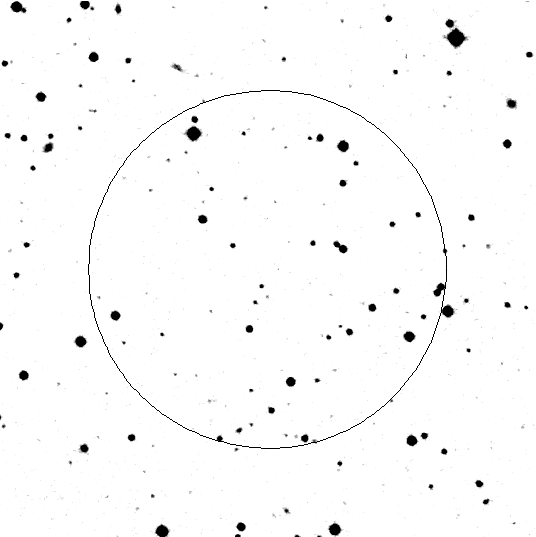
TITLE: GCN/SWIFT NOTICE
NOTICE_DATE: Thu 25 Oct 07 04:11:53 UT
NOTICE_TYPE: Swift-XRT Image
TRIGGER_NUM: 295301, Seg_Num: 0
GRB_RA: 355.0765d {+23h 40m 18.3s} (J2000),
355.1743d {+23h 40m 41.8s} (current),
354.4516d {+23h 37m 48.3s} (1950)
GRB_DEC: +31.7776d {+31d 46' 39.3"} (J2000),
+31.8209d {+31d 49' 15.3"} (current),
+31.5004d {+31d 30' 01.2"} (1950)
GRB_ERROR: 6.8 [arcsec, radius, statistical plus systematic]
GRB_INTEN: 27 [cnts]
IMG_START_DATE: 14398 TJD; 298 DOY; 07/10/25
IMG_START_TIME: 15079.88 SOD {04:11:19.88} UT, 146.2 [sec] since BAT Trigger Time
CENTROID_X: 305.33, raw= 305 [pixels]
CENTROID_Y: 281.71, raw= 282 [pixels]
ROLL: 294.49 [deg]
GAIN: 1
MODE: 2, Short Image mode
WAVEFORM: 134
EXPO_TIME: 0.10 [sec]
GRB_POS_XRT_Y: -38.38
GRB_POS_XRT_Z: 7.14
IMAGE_URL: sw00295301000msxps_rw.img
SUN_POSTN: 209.22d {+13h 56m 52s} -11.95d {-11d 56' 54"}
SUN_DIST: 142.94 [deg] Sun_angle= -9.7 [hr] (East of Sun)
MOON_POSTN: 14.02d {+00h 56m 04s} +9.63d {+09d 37' 55"}
MOON_DIST: 28.23 [deg]
MOON_ILLUM: 98 [%]
GAL_COORDS: 105.71,-28.70 [deg] galactic lon,lat of the burst
ECL_COORDS: 9.55, 30.81 [deg] ecliptic lon,lat of the burst
COMMENTS: SWIFT-XRT Image.

TITLE: GCN/SWIFT NOTICE
NOTICE_DATE: Thu 25 Oct 07 04:11:56 UT
NOTICE_TYPE: Swift-XRT Processed Image
TRIGGER_NUM: 295301, Seg_Num: 0
GRB_RA: 355.0765d {+23h 40m 18.3s} (J2000),
355.1743d {+23h 40m 41.8s} (current),
354.4516d {+23h 37m 48.3s} (1950)
GRB_DEC: +31.7776d {+31d 46' 39.3"} (J2000),
+31.8209d {+31d 49' 15.3"} (current),
+31.5004d {+31d 30' 01.2"} (1950)
GRB_ERROR: 6.8 [arcsec, radius, statistical plus systematic]
GRB_INTEN: 27 [cnts]
IMG_START_DATE: 14398 TJD; 298 DOY; 07/10/25
IMG_START_TIME: 15079.88 SOD {04:11:19.88} UT, 146.2 [sec] since BAT Trigger Time
CENTROID_X: 305.33, raw= 305 [pixels]
CENTROID_Y: 281.71, raw= 282 [pixels]
ROLL: 294.49 [deg]
GAIN: 1
MODE: 2, Short Image mode
WAVEFORM: 134
EXPO_TIME: 0.10 [sec]
GRB_POS_XRT_Y: -38.38
GRB_POS_XRT_Z: 7.14
IMAGE_URL: sw00295301000msxps_rw.img
SUN_POSTN: 209.22d {+13h 56m 52s} -11.95d {-11d 56' 54"}
SUN_DIST: 142.94 [deg] Sun_angle= -9.7 [hr] (East of Sun)
MOON_POSTN: 14.02d {+00h 56m 04s} +9.63d {+09d 37' 56"}
MOON_DIST: 28.23 [deg]
MOON_ILLUM: 98 [%]
GAL_COORDS: 105.71,-28.70 [deg] galactic lon,lat of the burst
ECL_COORDS: 9.55, 30.81 [deg] ecliptic lon,lat of the burst
COMMENTS: SWIFT-XRT Processed Image.

TITLE: GCN/SWIFT NOTICE
NOTICE_DATE: Thu 25 Oct 07 04:11:52 UT
NOTICE_TYPE: Swift-XRT Position
TRIGGER_NUM: 295301, Seg_Num: 0
GRB_RA: 355.0765d {+23h 40m 18.3s} (J2000),
355.1743d {+23h 40m 41.8s} (current),
354.4516d {+23h 37m 48.3s} (1950)
GRB_DEC: +31.7776d {+31d 46' 39.3"} (J2000),
+31.8209d {+31d 49' 15.3"} (current),
+31.5004d {+31d 30' 01.2"} (1950)
GRB_ERROR: 6.8 [arcsec radius, statistical plus systematic, 90% containment]
GRB_INTEN: 9.11e-09 [erg/cm2/sec]
GRB_SIGNIF: 5.19 [sigma]
IMG_START_DATE: 14398 TJD; 298 DOY; 07/10/25
IMG_START_TIME: 15079.88 SOD {04:11:19.88} UT, 146.2 [sec] since BAT Trigger Time
TAM[0-3]: 327.64 237.27 261.29 243.55
AMPLIFIER: 2
WAVEFORM: 134
SUN_POSTN: 209.22d {+13h 56m 52s} -11.95d {-11d 56' 54"}
SUN_DIST: 142.94 [deg] Sun_angle= -9.7 [hr] (East of Sun)
MOON_POSTN: 14.02d {+00h 56m 04s} +9.63d {+09d 37' 55"}
MOON_DIST: 28.23 [deg]
MOON_ILLUM: 98 [%]
GAL_COORDS: 105.71,-28.70 [deg] galactic lon,lat of the burst
ECL_COORDS: 9.55, 30.81 [deg] ecliptic lon,lat of the burst
COMMENTS: SWIFT-XRT Coordinates.
TITLE: GCN/SWIFT NOTICE
NOTICE_DATE: Thu 25 Oct 07 04:13:06 UT
NOTICE_TYPE: Swift-BAT GRB Lightcurve
TRIGGER_NUM: 295301, Seg_Num: 0
GRB_RA: 355.084d {+23h 40m 20s} (J2000),
355.182d {+23h 40m 44s} (current),
354.459d {+23h 37m 50s} (1950)
GRB_DEC: +31.757d {+31d 45' 24"} (J2000),
+31.800d {+31d 48' 01"} (current),
+31.480d {+31d 28' 46"} (1950)
GRB_DATE: 14398 TJD; 298 DOY; 07/10/25
GRB_TIME: 14933.68 SOD {04:08:53.68} UT
TRIGGER_INDEX: 20000
GRB_PHI: 135.85 [deg]
GRB_THETA: 30.58 [deg]
DELTA_TIME: 0.00 [sec]
TRIGGER_DUR: 64.000 [sec]
SOLN_STATUS: 0x13
RATE_SIGNIF: 0.00 [sigma]
IMAGE_SIGNIF: 10.87 [sigma]
LC_URL: sw00295301000msb.lc
SUN_POSTN: 209.22d {+13h 56m 53s} -11.95d {-11d 56' 55"}
SUN_DIST: 142.95 [deg] Sun_angle= -9.7 [hr] (East of Sun)
MOON_POSTN: 14.03d {+00h 56m 07s} +9.64d {+09d 38' 16"}
MOON_DIST: 28.21 [deg]
MOON_ILLUM: 98 [%]
GAL_COORDS: 105.71,-28.73 [deg] galactic lon,lat of the burst (or transient)
ECL_COORDS: 9.55, 30.79 [deg] ecliptic lon,lat of the burst (or transient)
COMMENTS: SWIFT-BAT GRB Lightcurve.
COMMENTS:
COMMENTS: The next comments were copied from the BAT_POS Notice:
COMMENTS: This is an image trigger.
COMMENTS: A point_source was found.
COMMENTS: This does not match any source in the on-board catalog.
COMMENTS: This does not match any source in the ground catalog.
COMMENTS: This is a GRB.
COMMENTS: This trigger occurred at longitude,latitude = 333.73,18.11 [deg].
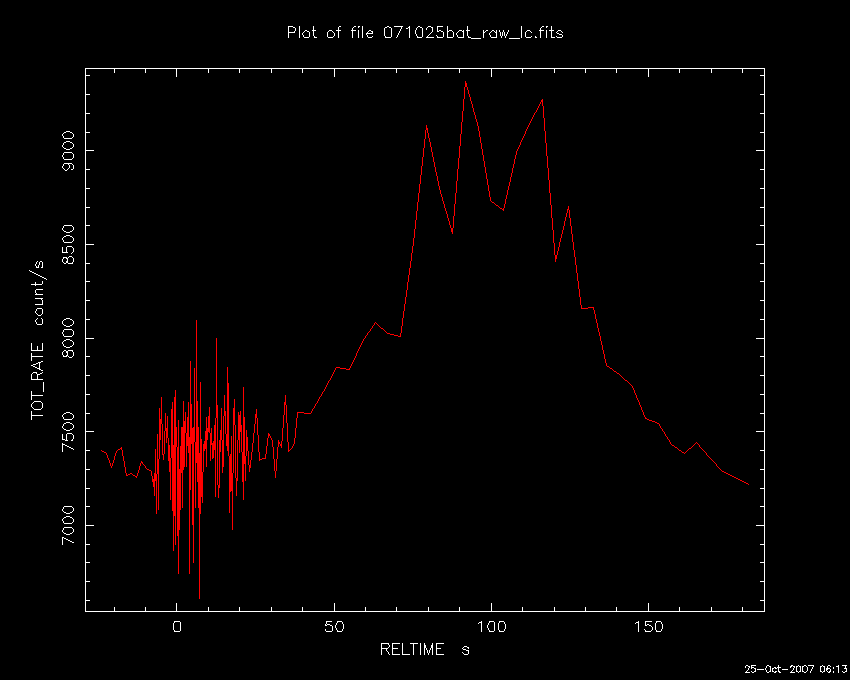
TITLE: GCN/SWIFT NOTICE
NOTICE_DATE: Thu 25 Oct 07 04:14:12 UT
NOTICE_TYPE: Swift-UVOT Source List
TRIGGER_NUM: 295301, Seg_Num: 0
POINT_RA: 355.068d {+23h 40m 16s} (J2000)
POINT_DEC: +31.767d {+31d 46' 02"} (J2000)
POINT_ROLL: 294.486d
IMG_START_DATE: 14398 TJD; 298 DOY; 07/10/25
IMG_START_TIME: 15088.58 SOD {04:11:28.58} UT, 154.9 [sec] since BAT Trigger Time
FILTER: 10, White
BKG_MEAN: 1.298
N_STARS: 42
X_OFFSET: 352 [pixels]
Y_OFFSET: 576 [pixels]
X_MAX: 1311 [pixels]
Y_MAX: 1535 [pixels]
DET_THRESH: 10
PHOTO_THRESH: 5
SL_URL: sw00295301000msufc0154.fits
SUN_POSTN: 209.22d {+13h 56m 53s} -11.95d {-11d 56' 56"}
SUN_DIST: 142.93 [deg] Sun_angle= -9.7 [hr] (East of Sun)
MOON_POSTN: 14.04d {+00h 56m 09s} +9.64d {+09d 38' 34"}
MOON_DIST: 28.23 [deg]
MOON_ILLUM: 98 [%]
GAL_COORDS: 105.70,-28.71 [deg] galactic lon,lat of the pointing direction
ECL_COORDS: 9.54, 30.80 [deg] ecliptic lon,lat of the pointing direction
COMMENTS: SWIFT-UVOT Source List.
TITLE: GCN/SWIFT NOTICE
NOTICE_DATE: Thu 25 Oct 07 04:15:28 UT
NOTICE_TYPE: Swift-UVOT Image
TRIGGER_NUM: 295301, Seg_Num: 0
POINT_RA: 355.068d {+23h 40m 16s} (J2000)
POINT_DEC: +31.767d {+31d 46' 02"} (J2000)
ROLL: 294.486d
IMG_START_DATE: 14398 TJD; 298 DOY; 07/10/25
IMG_START_TIME: 15088.58 SOD {04:11:28.58} UT, 154.9 [sec] since BAT Trigger Time
FILTER: 10, White
EXPOSURE_ID: 214978290
X_OFFSET: 821 [pixels]
Y_OFFSET: 949 [pixels]
WIDTH: 160 [pixels]
HEIGHT: 160 [pixels]
X_GRB_POS: 981
Y_GRB_POS: 1109
BINNING_INDEX: 1
IM_URL: sw00295301000msuni0154.fits
SUN_POSTN: 209.22d {+13h 56m 53s} -11.95d {-11d 56' 57"}
SUN_DIST: 142.93 [deg] Sun_angle= -9.7 [hr] (East of Sun)
MOON_POSTN: 14.05d {+00h 56m 12s} +9.65d {+09d 38' 55"}
MOON_DIST: 28.23 [deg]
MOON_ILLUM: 98 [%]
GAL_COORDS: 105.70,-28.71 [deg] galactic lon,lat of the pointing direction
ECL_COORDS: 9.54, 30.80 [deg] ecliptic lon,lat of the pointing direction
COMMENTS: SWIFT-UVOT Image.
COMMENTS: The GRB Position came from the XRT Position Command.
COMMENTS: The image has 2x2 binning (compression).
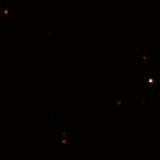
TITLE: GCN/SWIFT NOTICE
NOTICE_DATE: Thu 25 Oct 07 04:16:01 UT
NOTICE_TYPE: Swift-UVOT Processed Image
TRIGGER_NUM: 295301, Seg_Num: 0
POINT_RA: 355.068d {+23h 40m 16s} (J2000)
POINT_DEC: +31.767d {+31d 46' 02"} (J2000)
ROLL: 294.486d
IMG_START_DATE: 14398 TJD; 298 DOY; 07/10/25
IMG_START_TIME: 15088.58 SOD {04:11:28.58} UT, 154.9 [sec] since BAT Trigger Time
FILTER: 10, White
EXPOSURE_ID: 214978290
X_OFFSET: 821 [pixels]
Y_OFFSET: 949 [pixels]
WIDTH: 160 [pixels]
HEIGHT: 160 [pixels]
X_GRB_POS: 981
Y_GRB_POS: 1109
BINNING_INDEX: 1
IM_URL: sw00295301000msuni0154.fits
SUN_POSTN: 209.22d {+13h 56m 53s} -11.95d {-11d 56' 57"}
SUN_DIST: 142.93 [deg] Sun_angle= -9.7 [hr] (East of Sun)
MOON_POSTN: 14.06d {+00h 56m 14s} +9.65d {+09d 39' 04"}
MOON_DIST: 28.23 [deg]
MOON_ILLUM: 98 [%]
GAL_COORDS: 105.70,-28.71 [deg] galactic lon,lat of the pointing direction
ECL_COORDS: 9.54, 30.80 [deg] ecliptic lon,lat of the pointing direction
COMMENTS: SWIFT-UVOT Processed Image.
COMMENTS: The GRB Position came from the XRT Position Command.
COMMENTS: The image has 2x2 binning (compression).
COMMENTS: If you have elected to receive attachments:
COMMENTS: The uvot_sources_image.fits.gz file does not exist; skipping the attachment.
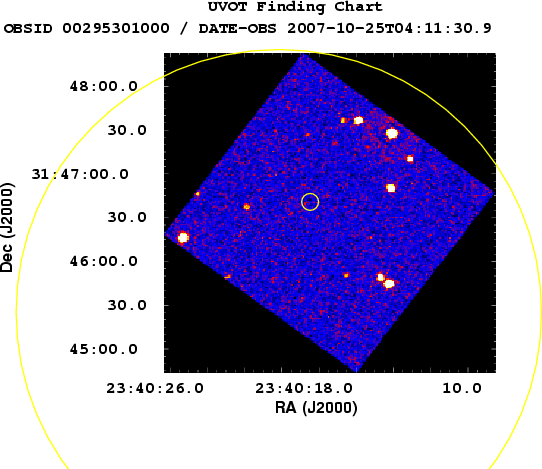
TITLE: GCN/SWIFT NOTICE
NOTICE_DATE: Thu 25 Oct 07 04:17:17 UT
NOTICE_TYPE: Swift-UVOT Source List
TRIGGER_NUM: 295301, Seg_Num: 0
POINT_RA: 355.069d {+23h 40m 17s} (J2000)
POINT_DEC: +31.769d {+31d 46' 07"} (J2000)
POINT_ROLL: 294.488d
IMG_START_DATE: 14398 TJD; 298 DOY; 07/10/25
IMG_START_TIME: 15194.62 SOD {04:13:14.62} UT, 260.9 [sec] since BAT Trigger Time
FILTER: 3, V
BKG_MEAN: 0.447
N_STARS: 33
X_OFFSET: 501 [pixels]
Y_OFFSET: 629 [pixels]
X_MAX: 1460 [pixels]
Y_MAX: 1588 [pixels]
DET_THRESH: 6
PHOTO_THRESH: 3
SL_URL: sw00295301000msufc0260.fits
SUN_POSTN: 209.22d {+13h 56m 53s} -11.95d {-11d 56' 59"}
SUN_DIST: 142.93 [deg] Sun_angle= -9.7 [hr] (East of Sun)
MOON_POSTN: 14.07d {+00h 56m 16s} +9.66d {+09d 39' 26"}
MOON_DIST: 28.24 [deg]
MOON_ILLUM: 98 [%]
GAL_COORDS: 105.70,-28.71 [deg] galactic lon,lat of the pointing direction
ECL_COORDS: 9.54, 30.80 [deg] ecliptic lon,lat of the pointing direction
COMMENTS: SWIFT-UVOT Source List.
TITLE: GCN/SWIFT NOTICE
NOTICE_DATE: Thu 25 Oct 07 04:18:06 UT
NOTICE_TYPE: Swift-UVOT Image
TRIGGER_NUM: 295301, Seg_Num: 0
POINT_RA: 355.069d {+23h 40m 17s} (J2000)
POINT_DEC: +31.769d {+31d 46' 07"} (J2000)
ROLL: 294.488d
IMG_START_DATE: 14398 TJD; 298 DOY; 07/10/25
IMG_START_TIME: 15194.62 SOD {04:13:14.62} UT, 260.9 [sec] since BAT Trigger Time
FILTER: 3, V
EXPOSURE_ID: 214978396
X_OFFSET: 821 [pixels]
Y_OFFSET: 949 [pixels]
WIDTH: 160 [pixels]
HEIGHT: 160 [pixels]
X_GRB_POS: 981
Y_GRB_POS: 1109
BINNING_INDEX: 1
IM_URL: sw00295301000msuni0260.fits
SUN_POSTN: 209.22d {+13h 56m 53s} -11.95d {-11d 57' 00"}
SUN_DIST: 142.93 [deg] Sun_angle= -9.7 [hr] (East of Sun)
MOON_POSTN: 14.08d {+00h 56m 18s} +9.66d {+09d 39' 39"}
MOON_DIST: 28.24 [deg]
MOON_ILLUM: 98 [%]
GAL_COORDS: 105.70,-28.71 [deg] galactic lon,lat of the pointing direction
ECL_COORDS: 9.54, 30.80 [deg] ecliptic lon,lat of the pointing direction
COMMENTS: SWIFT-UVOT Image.
COMMENTS: The GRB Position came from the XRT Position Command.
COMMENTS: The image has 2x2 binning (compression).
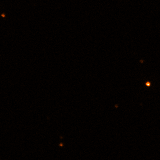
RA(J2000) = 23h 40m 20s Dec(J2000) = +31d 45' 24"with an uncertainty of 3 arcmin (radius, 90% containment, including systematic uncertainty). Although this is a 64 sec image trigger, the light curve appears to have a single broad peak with duration about 120 sec near time T+100, with peak count rate 2000 ct/s.
RA(J2000) = 23h 40m 18.3s Dec(J2000) = 31d 46' 39.3"with an uncertainty of 6.8 arcseconds (radius, 90% containment). This location is 78 arcseconds from the BAT on-board position, within the BAT error circle. The initial flux in the 0.1s image was 9.1e-09 erg/cm2/s (0.2-10 keV).
start UT mag mlim(of image) ---------------------------------- 04:16:27.1 19.2 18.6This source is not visible in DSS (second epoch), 2MASS or the MPChecker database.
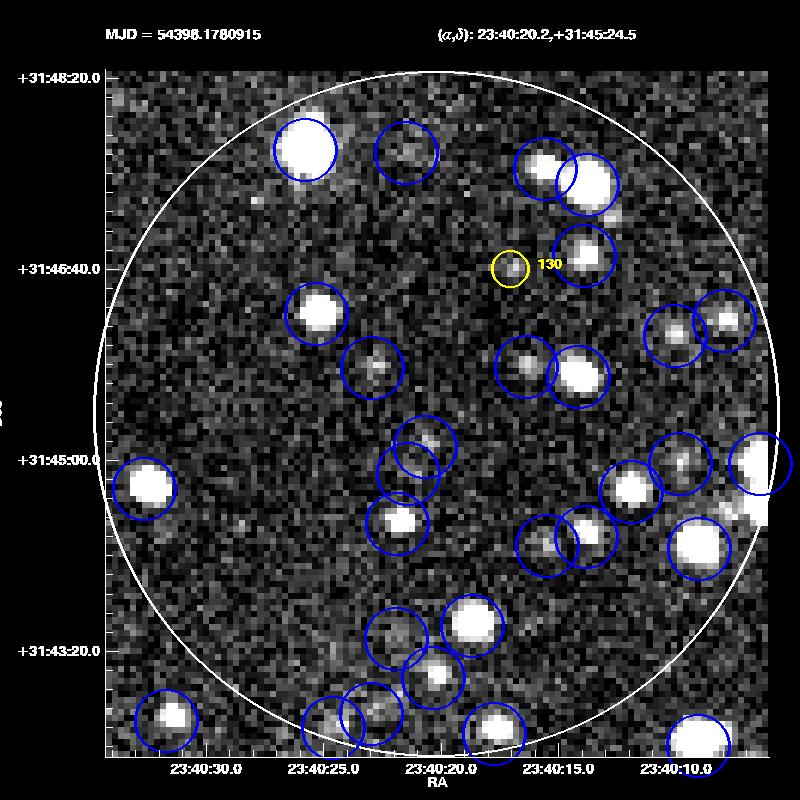
TITLE: GCN/SWIFT NOTICE
NOTICE_DATE: Thu 25 Oct 07 04:18:49 UT
NOTICE_TYPE: Swift-UVOT Processed Image
TRIGGER_NUM: 295301, Seg_Num: 0
POINT_RA: 355.069d {+23h 40m 17s} (J2000)
POINT_DEC: +31.769d {+31d 46' 07"} (J2000)
ROLL: 294.488d
IMG_START_DATE: 14398 TJD; 298 DOY; 07/10/25
IMG_START_TIME: 15194.62 SOD {04:13:14.62} UT, 260.9 [sec] since BAT Trigger Time
FILTER: 3, V
EXPOSURE_ID: 214978396
X_OFFSET: 821 [pixels]
Y_OFFSET: 949 [pixels]
WIDTH: 160 [pixels]
HEIGHT: 160 [pixels]
X_GRB_POS: 981
Y_GRB_POS: 1109
BINNING_INDEX: 1
IM_URL: sw00295301000msuni0260.fits
SUN_POSTN: 209.22d {+13h 56m 53s} -11.95d {-11d 57' 00"}
SUN_DIST: 142.93 [deg] Sun_angle= -9.7 [hr] (East of Sun)
MOON_POSTN: 14.08d {+00h 56m 20s} +9.66d {+09d 39' 51"}
MOON_DIST: 28.24 [deg]
MOON_ILLUM: 98 [%]
GAL_COORDS: 105.70,-28.71 [deg] galactic lon,lat of the pointing direction
ECL_COORDS: 9.54, 30.80 [deg] ecliptic lon,lat of the pointing direction
COMMENTS: SWIFT-UVOT Processed Image.
COMMENTS: The GRB Position came from the XRT Position Command.
COMMENTS: The image has 2x2 binning (compression).
COMMENTS: If you have elected to receive attachments:
COMMENTS: The uvot_sources_image.fits.gz file does not exist; skipping the attachment.
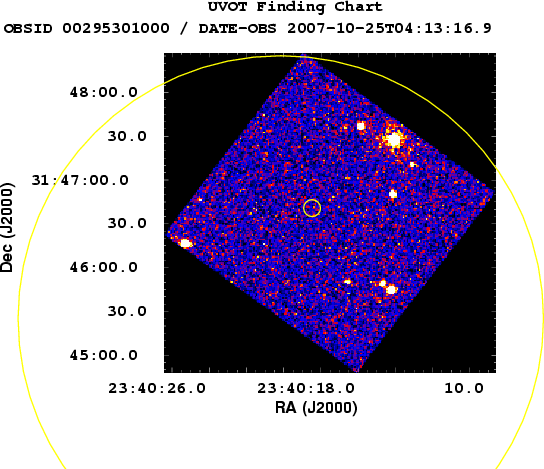
TITLE: GCN/SWIFT NOTICE
NOTICE_DATE: Thu 25 Oct 07 04:14:42 UT
NOTICE_TYPE: Swift-UVOT Processed Source List
TRIGGER_NUM: 295301, Seg_Num: 0
POINT_RA: 355.068d {+23h 40m 16s} (J2000)
POINT_DEC: +31.767d {+31d 46' 02"} (J2000)
POINT_ROLL: 294.486d
IMG_START_DATE: 14398 TJD; 298 DOY; 07/10/25
IMG_START_TIME: 15088.58 SOD {04:11:28.58} UT, 154.9 [sec] since BAT Trigger Time
FILTER: 10, White
BKG_MEAN: 1.298
N_STARS: 42
X_OFFSET: 352 [pixels]
Y_OFFSET: 576 [pixels]
X_MAX: 1311 [pixels]
Y_MAX: 1535 [pixels]
DET_THRESH: 10
PHOTO_THRESH: 5
SL_URL: sw00295301000msufc0154.fits
SUN_POSTN: 209.22d {+13h 56m 53s} -11.95d {-11d 56' 56"}
SUN_DIST: 142.93 [deg] Sun_angle= -9.7 [hr] (East of Sun)
MOON_POSTN: 14.04d {+00h 56m 11s} +9.65d {+09d 38' 42"}
MOON_DIST: 28.23 [deg]
MOON_ILLUM: 98 [%]
GAL_COORDS: 105.70,-28.71 [deg] galactic lon,lat of the pointing direction
ECL_COORDS: 9.54, 30.80 [deg] ecliptic lon,lat of the pointing direction
COMMENTS: SWIFT-UVOT Processed Source List.
COMMENTS: All 4 attachments are included.

TITLE: GCN/SWIFT NOTICE
NOTICE_DATE: Thu 25 Oct 07 04:18:23 UT
NOTICE_TYPE: Swift-UVOT Processed Source List
TRIGGER_NUM: 295301, Seg_Num: 0
POINT_RA: 355.069d {+23h 40m 17s} (J2000)
POINT_DEC: +31.769d {+31d 46' 07"} (J2000)
POINT_ROLL: 294.488d
IMG_START_DATE: 14398 TJD; 298 DOY; 07/10/25
IMG_START_TIME: 15194.62 SOD {04:13:14.62} UT, 260.9 [sec] since BAT Trigger Time
FILTER: 3, V
BKG_MEAN: 0.447
N_STARS: 33
X_OFFSET: 501 [pixels]
Y_OFFSET: 629 [pixels]
X_MAX: 1460 [pixels]
Y_MAX: 1588 [pixels]
DET_THRESH: 6
PHOTO_THRESH: 3
SL_URL: sw00295301000msufc0260.fits
SUN_POSTN: 209.22d {+13h 56m 53s} -11.95d {-11d 57' 00"}
SUN_DIST: 142.93 [deg] Sun_angle= -9.7 [hr] (East of Sun)
MOON_POSTN: 14.08d {+00h 56m 19s} +9.66d {+09d 39' 44"}
MOON_DIST: 28.24 [deg]
MOON_ILLUM: 98 [%]
GAL_COORDS: 105.70,-28.71 [deg] galactic lon,lat of the pointing direction
ECL_COORDS: 9.54, 30.80 [deg] ecliptic lon,lat of the pointing direction
COMMENTS: SWIFT-UVOT Processed Source List.
COMMENTS: All 4 attachments are included.
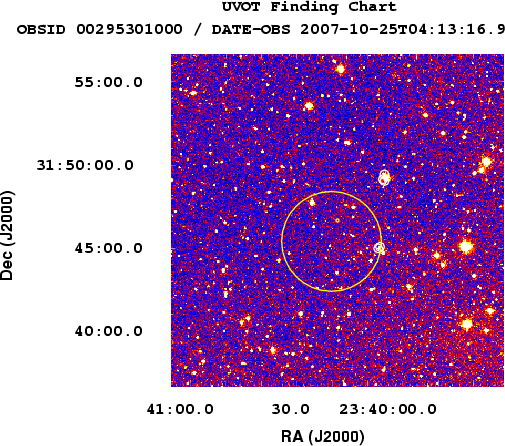
RA = 23:40:17.1 DEC = 31:46:43.6with H~13.8 at 4:18:12 UT.
RA(J2000) =23h 40m 17.7s Dec(J2000) =+31d 46' 41.4"with an uncertainty of 8 arcseconds (radius, 90% containment).
Star time (UT) Exp Time I mag
--------------------------------------
04:38:08 300s 16.8
05:08:42 300s 17.2
05:30:48 300s 18.1
Further examination of the BVRI data is ongoing to check
whether this is a red GRB or high-z GRB.
t_start (UT) t_mid (UT) exp t (s) t_start-t_0 (s) R Mag -------------------------------------------------------------------------------------- 04:10:29.3 04:10:34.3 10 95.3 R > 17.3 04:13:42.1 04:13:52.1 20 288.1 R > 17.8 04:14:08.8 04:19:39.0 600 314.8 R =17.97 +/- 0.17Our upper limit of R > 17.8 was measured near the time of the unfiltered m=17.3 peak reported by Rykoff et al. (GCN 6992). Additional observations and analysis are ongoing.
RA(J2000) = 23h 40m 15.6s Dec(J2000) = 31d 47' 3"with an uncertainty of 1.3 arcmin, (radius, sys+stat, 90% containment). The partial coding was 48%.
RA (J2000): 23 40 17.14 Dec (J2000): +31 46 42.9with an uncertainty of 1.7 arcsec (radius, 90% confidence). This is 7.1 arcsec from the refined XRT position (GCN Circ. 6990) and 0.7 arcsec from the optical afterglow found by ROTSE-III at McDonald Observatory (Rykoff et al., GCN Circ. 6987).
Filter Tstart Tstop Exp Magnitude
(s) (s) (s) (3-sigma UL)
White 155 16016 1377 22.82
v 137 17760 1319 21.22
b 3968 11968 1194 22.14
u 3760 23536 2085 22.13
uvw1 3552 22704 2164 22.05
uvm2 4784 21808 1082 21.43
uvw2 4368 16928 1279 21.89
The values quoted above are not corrected for the expected Galactic
extinction corresponding to a reddening of E_{B-V} = 0.074 mag in the
direction of the burst (Schlegel et al. 1998).
***************************************************** Joshua Bloom Assistant Professor, UC Berkeley 601 Campbell Hall, Berkeley, CA 94720 (510) 643-3839 [Office] 447 Campbell (510) 643-4621 [Lab] 260 Evans http://astro.berkeley.edu/~jbloom *****************************************************
J=17.34 +/- 0.05 H=16.37 +/- 0.05 K=15.45 +/- 0.05The photometric errors are dominated by the zeropoint uncertainties from our calibration procedure. The photon noise on the measuremens is <0.01.
Xiaohui Fan Steward Observatory The University of Arizona 933 N. Cherry Ave. Tucson, AZ 85721-0065 Email: fan@as.arizona.edu Tel: (520) 626-7558 Fax: (520) 621-1532URL: http://sancerre.as.arizona.edu/~fan
Start time End time Exp Mag ---------------------------------------------------------- 0.03394 0.04328 4x180s R > 18.6 0.04405 0.05559 2x180s + 2x240s V > 19.1 0.05586 0.10521 10x240s I > 19.3The SARA website may be found at http://astro.fit.edu/sara/sara.html
Filter UT-Start UT-End exp (s) magnitude error R ---- 04:37:08 ----- 04:41:30 ---- 150 --- 18.7 +/- 0.1 R ---- 04:42:14 ----- 05:02:40 ---- 1080 -- 19.3 +/- 0.1 R ---- 05:03:12 ----- 05:24:11 ---- 1080 -- 19.8 +/- 0.1 V ---- 05:43:38 ----- 06:07:46 ---- 1200 -- < 22.0 I ---- 05:25:05 ----- 05:42:39 ---- 960 -- 18.2 +/- 0.1 I ---- 08:01:20 ----- 08:55:41 ---- 3000 -- 19.9 +/- 0.15This message may be cited.
Filter midtime(UTC) Exp. time magnitude/upper limits J 2007-10-25 06:59 10 17.73 +- 0.06 R 2007-10-25 07:01 10 21.5 +- 0.4 Y 2007-10-25 07:21 9 detected I 2007-10-25 07:21 10 19.97 +- 0.13 K 2007-10-25 07:43 8 16.67 +- 0.07 R 2007-10-25 07:43 10 > 20.9 H 2007-10-25 08:04 9 17.59 +- 0.08 I 2007-10-25 08:04 10 20.3 +- 0.2 J 2007-10-25 08:25 9 18.29 +- 0.10 R 2007-10-25 08:25 10 > 21.0 Y 2007-10-25 08:44 9 marginally detected I 2007-10-25 08:44 10 20.5 +- 0.3The magnitude and the 3-sigma upper limits were derived using the USNO-B1.0 and 2MASS catalogues. The magnitude error does not include the error of the calibration source. The Y-band observations have not been calibrated.